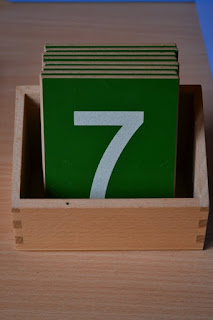Today, I concentrated on my Practical Life area. I took all the trays off the shelves and thought hard about what I wanted to achieve. Basically, I came to realise that my goal for the beginning of the year is to have many activities out that are easy for my youngest children to complete successfully. it is going to be alot for them to absorb when they arrive in our classroom (I am talking about the "newcomers") as they will be busy learning how to choose work, take it from the shelf to a table or the floor, complete the work and finally return it. It is quite a lot to digest for them and I usually spent the first 2 weeks or so showing them how to do it properly. So for the beginning of the year, I needed to choose activities that "returning" children can complete without much adult help in order to increase their independence and confidence. Hopefuly this will allow me and my assistant Rachel to spend the bulk of our time helping our new children learn the ground rules those first few weeks.
Of course, I will rotate materials on these shelves throughout the year. However, I always have out increasingly difficult variations of pouring, spooning, beading and grasping activities for the entire year on these shelves.
So at the moment, this is what our little practical life area looks like:
And here are the details:
 |
| These are our frames (sorry, the picture is upside down!!) |
 |
| Pouring activity with couscous. I got the jugs at a car boot sale the other day for 50cent (both!!) |
 |
| Tongs and marbles. Great for little fingers (pre-writing exercise). And I got my cute little duck from Karen (Little Acorns)!! Thanks again Karen. |
 |
| This exercise is brilliant for the small muscles of the hand and it teaches the concepts of right and left. Each bolts, washers and nuts are graduated in size which makes the whole activity a great mathematical and sensorial exercise. |
 |
| Polishing exercise. We will be using Johnson's Cream (non-toxic). And isn't my litle brush cute..? |
 |
| Using chopsticks with runner beans |
 |
| Balancing game with Lola and Charlie |
 |
| Opening, zipping, twisting, closing exercise |
 |
| Using a dropper .. Great dexterity exercise.. |
 |
| Spooning |
 |
| Spooning round plastic vegetables using a larger spoon |
 |
| Lacing |
 |
| More bolts exercise, and hand eye coordination activities |
 |
| A simpe salad bowl with colourful pegs. Again hand eye coordination (pre-writing exercise) and a sensorial game too with the matching of colours. |
 |
| Beading games. On the left, we are using large chunky wooden bits (flowers, fruits and vegies) for the little ones not used to beading. On the right, smaller beads for the more "experienced" preschoolers. |
 |
| A great cutting exercise. The pieces of fruit and vegetables are joined together with a velcro. I got the game on Amazon.uk |
 |
| Pouring activity using a funnel and sand |
 |
| Hammering activity |
 |
And finally,our playdough... Very popular
|
I still haven't finished sawing my 3 white squares of fabric which we will be using for our folding exercise. I will take a picture when I am done with them and add a quick post about them. That's it for now though. Hope you like it.





















































